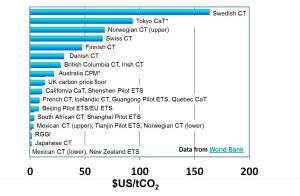What is the “Right” Price?
We know that GHG emissions are causing damage. If we can estimate how much carbon emissions actually cost – often called the Social Cost of Carbon (SCC) – it will help guide us to the “right” price. But those cost estimates range widely — from US$10/tCO2e to over US$400/tCO2e.
A FEMA study estimates that 1 foot of sea level rise by 2050, which is indeed likely would cause 40-60% more damage than at current sea level, principally from storm surges. And as hurricanes and storms become more intense, that damage continues upward. Estimates of Hurricane Sandy cost is on the order of $65 billion. And these are only the direct costs. Indirect costs such as health, crop uncertainties, and many others add up. The EPA has estimated the Social Cost of Carbon (SCC) to be US$37/tCO2e, while a Stanford study published in 2014 estimates SCC to be US$220/tCO2e. Part of the difference is that the Stanford study includes environmental costs. “Calculating” a SCC is perhaps a misnomer. For example how do we put a price on the loss of biodiversity which is essential to human health?
Cost of Waiting vs Economic Growth
A seriously studied look at the cost of climate change is reported in the 2010 Stern Review. In broad strokes, the Stern Review estimates the cost of doing nothing as roughly losing 5% of global GDP PER YEAR. Current global GDP is US$77 trillion. So the cost estimated is on the order of US$3.8 trillion. And that cost would grow with time. That would be a cost which is a drag on the economy, rebuilding what was already built. Conversely the Stern Review estimates the cost of acting now as 1% of global GDP per year. And that cost would be building for the future, not for the past, strengthening the economy rather than standing still. These numbers roughly agree with an estimate by Hudson Clean Energy Partners that decarbonizing the US economy by half would take US$45 trillion from 2010 to 2050.
We’re Running Out of Time
Whatever the pricing mechanism, we need to get started now. The longer we wait, the more it will cost. Price incentives will foster the innovation and investment we need to protect our economy and move forward quickly.
Current Carbon Prices
2015 prices ranged from US$1/tCO2e (Mexico) to US$168/tCO2e (Sweden) with most in the range of US$12/tCO2e, as seen in the chart below. Most prices are well below even the conservative estimates for the cost of carbon.
Last updated August 29, 2017

